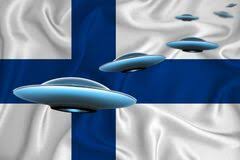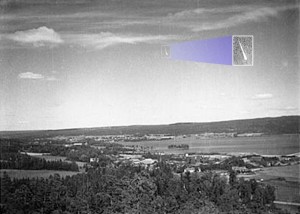By Charles Lear
 The history of UFO reports in Finland is much like that of other countries except that it starts earlier than most, dating back to the early 20th century. As was the case for much of Scandinavia, Finland had reports in the 1930s and 1940s of mystery lights, aircraft and rockets but, unlike its neighbors and much of Europe, the government of Finland has been quite secretive regarding official UFO investigations. Despite the government’s secrecy, documents have been released and were examined by private researchers. These documents revealed that Finnish defense organizations were actively investigating UFO reports from the very beginning and some intriguing cases have been brought to light.
The history of UFO reports in Finland is much like that of other countries except that it starts earlier than most, dating back to the early 20th century. As was the case for much of Scandinavia, Finland had reports in the 1930s and 1940s of mystery lights, aircraft and rockets but, unlike its neighbors and much of Europe, the government of Finland has been quite secretive regarding official UFO investigations. Despite the government’s secrecy, documents have been released and were examined by private researchers. These documents revealed that Finnish defense organizations were actively investigating UFO reports from the very beginning and some intriguing cases have been brought to light.
Finland has the distinction of having an abduction account from 1917. The first printed version of that account appeared in the June 9, 1978 edition of the newspaper, Kurkijokelainen, and was written by Latomäen Aino. According to the story, a widow, Anni, was missing from her house in the community of Jyrinvaara for several days. Neighbors had thought she’d been away visiting her daughter but, when she reappeared, she had an unusual explanation for her absence. According to her, a large craft, shaped like a washbasin, had descended next to her house and small creatures came down out of it using a ladder. She was able to partially understand their language and, after refusing their invitation to come aboard, was taken by force. The craft flew off and she described being taken all over the planet and then among the stars.
An investigator from The UFO Research of Finland, Mauritz Hietamäki, located one of Anni’s neighbors, “Mrs. N.N.” who was born in 1910 and was a young girl at the time. N.N. told Hietamäki that Anni’s full name was Anni Lattu, that she was born in 1873, died in 1930, and that she was not a widow. Her husband, Juho, actually died 11 years after she did, but she may have lived alone as N.N. described that she was always alone when visiting. Because there was no extraterrestrial context for Lattu’s experience, the villagers called the creatures “devils” and Lattu went on to do so as well.
During the winter between 1933 and 1934, many people in Sweden reported seeing mysterious aircraft, some with bright lights (unusual for the period) that were able to fly in harsh weather conditions, day or night. The Swedish Air Force sent out planes to look for the aircraft and ski patrols were sent to man mountaintop searchlights. The Finnish Army sent up their own planes and the first report came from Kemi, a town just east of the Swedish border, which described “a shining bright light, just like a blowtorch.” The report received a good deal of press coverage and Finnish authorities declared, without proof, that the light was from something of Russian origin. At a 1937 press conference, spokesmen for the Finnish military declared that all the sightings could be explained by weather formations and inaccurate observations.
 In 1946, Scandinavia experienced a wave of reports, beginning in Helsinki, Finland, describing rockets that flew over witnesses, sometimes changed course and returned from where they came. There were reports of some rockets crashing into lakes but, despite careful searches by officials, none were recovered. The immediate thought was that the Russians were testing captured German technology after the war but this has never been established. The reports caused genuine, worldwide military concern, which is confirmed by documents from the period.
In 1946, Scandinavia experienced a wave of reports, beginning in Helsinki, Finland, describing rockets that flew over witnesses, sometimes changed course and returned from where they came. There were reports of some rockets crashing into lakes but, despite careful searches by officials, none were recovered. The immediate thought was that the Russians were testing captured German technology after the war but this has never been established. The reports caused genuine, worldwide military concern, which is confirmed by documents from the period.
According to a blog posted on the Finish UFO Network website in 2009, over 300 government documents concerning official UFO investigations from 1933 to 1979, were briefly made available until the public military archive was shut down. The writer describes that, after 1937, the Finnish military stopped publicly acknowledging an interest in UFO reports. Along with the seeming military disinterest, there was a public disinterest as well. Despite the worldwide flying saucer frenzy of the late 1940’s and 1950’s, Finland’s first private research group, Lentävät lautaset- kerho (the Flying Saucer Club), didn’t form until 1960 and the most famous cases come from the years after that.
In August of 1964, Raimo Blomqvist, was on an island in the middle of Lake Kallavesi visiting his parents at their summer cottage. At around 7:00 PM, he saw a glowing object he described as a “fishcock” which was a local epicurean delight consisting of fish and meat baked in bread. The object descended and hovered over shallow water, close to the island, and Blomqvist reported seeing something fall from the object, which entered the water with a hiss. The object then glowed brightly, shot up into the clouds and was gone from sight. Blomqvist retrieved the fallen substance from the water, which was a stone 3-4 cm long with five visible layers. He gave the stone to investigators at the Finish UFO Research Association who had it tested, and it was found to be made up of mostly iron that had experienced extended temperatures between 650°C and 800°C.
On December 12, 1969, an incident occurred at an Air Force training camp in the southwest town of Pori. With nearly 20 pilots observing, 7 yellow balls of light appeared and hovered around 2000 meters above the airfield. A pilot who was in the midst of training maneuvers, Tarmo Tukeva, was ordered to investigate. He was flying a Fouga Magister jet and as he approached, the objects sped off against an estimated 185 km/h wind, too fast for him to pursue. The objects were seen on radar and the incident remains the only case officially acknowledged by the Finnish Air Force as “unexplained.”
Finland’s most internationally known case comes from the village of Imjärvi, in 1970. On a winter day at around 4:45 PM, two men, Aarno Heinonen, 36, and Esko Viljo, 38, were cross-country skiing. They stopped to rest and, through a break in the trees, reportedly saw a yellow-orange, oblong object in the sky. They heard a sound like the humming of bees and then saw a grey disk, about 2 meters in diameter, hovering 3-4 meters above the ground. A ball, approximately 15 cm in diameter, descended as the object emitted gray-red smoke, hit the ground, changed into a disk emitting beams of colored light, changed back into a ball and returned to the object. The men then saw a thin creature, 90 cm tall, with a curved nose, light green uniform, white gloves and a pointed hat. On its chest was a black box with a white button that emitted a pulsating light. The entire sighting lasted about 15 seconds, after which the creature and the craft were shrouded in smoke and disappeared. Both men were left with severe muscle pains and sought medical attention. Heinonen went on to become a contactee, claiming interaction with a female humanoid and healing ability.
More recently, FUFORA analyzed videos of UFOs taken by “officials” with infrared cameras in November, 2003 and April, 2005. The videos were posted on youtube along with some back story but it’s not clear who took the videos and how FUFORA got access to them. According to a FUFORA investigator writing about famous Finnish cases, FUFORA had often tried to reach out to the Finnish Air Force and occasionally received cooperation from “certain persons.” Of note is the fact that a former Air Force head, Rauno Meriö, had a personal interest in UFOs (to where he translated the 1969 book by Charles Bowen, “The Humanoids”) and yet refused to publicly comment on them. According to this same writer, FUFORA also tried to work with the Army by offering them their reports but ceased negotiations when it appeared that the Army was looking for a one-way arrangement.
There are many other cases and investigations are ongoing, but Finland’s UFO history remains obscure to most researchers. Researching this blog was difficult as much of the available material is badly translated and this may be part of the reason for the obscurity. Even so, the tales do manage to transcend the language barrier.